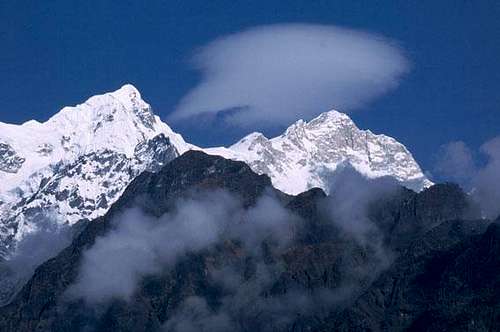-
 99509 Hits
99509 Hits
-
 94.89% Score
94.89% Score
-
 51 Votes
51 Votes
|
|
Mountain/Rock |
|---|---|
|
|
28.54940°N / 84.56190°E |
|
|
26758 ft / 8156 m |
|
|
Overview
Manaslu (also known as Kutang) is the eighth highest mountain in the world. It is located forty miles east of Annapurna and dominates the Gurkha massif. The mountain's long ridges and valley glaciers offer feasible approaches from all directions, and it culminates in a peak that towers steeply above its surrounding landscape, and is a dominant feature when seen from afar. This mountain was previously known as Kutan l. 'tang' being the Tibetan word for flat place, thereby describing the mountain's general summit. The name was later changed to Manaslu, which is derived from the Sanskrit word Manasa and can be roughly translated as Mountain of the Spirit.
The first ascent of this peak was in 1956 by T. Imanishi and Gyalzen Norbu (Japanese expedition). The peak was not climbed again until 1971 when a Japanese team made the second ascent. It was not until 1997 that Charlie Mace made the first American ascent. There are a half dozen established routes on the mountain today, the south face being arguably the toughest in climbing history. As of 2003, the peak has seen only 240 successful ascents and 52 fatalities, making it the 4th most dangerous 8000m peak, behind Annapurna, Nanga Parbat, and K2.
Getting There
All routes to the base camp of Manaslu begin in Kathmandu. Expedition Time: Approximate time 62 days
The Trek to Base Camp:
Bus from Kathmandu to Gorkha. Trek from Gorkha to Arughat. Trek through rice paddies to Sundi Khola. Trek through forest to Macha Khola. Trek along riverbanks of Budhi Gandaki to Jagat. Continue along the river to Deng. Continue along river to Ghap, a Buddhist village. Continue along river to Sho. Trek to Pungen Gompa. Rest day. Trek to Sama Gaon. Trek to Manaslu base. Rest in Manaslu base.
Climb Manaslu 35 to 40-day window.
Trek Out: Trek down to Samagaon. Trek down to Nyak. Trek down to Jagat. Trek down to Macha Khola. Trek down to Arughat. Trek down to Gorkha. Bus to Kathmandu.
History
History and Notable Ascents of Manaslu
| Year | Route | Notes |
| 1950 | Reconnaissance Trip | H.W. Tilman, made a reconnaissance trip to Manaslu after his unsuccessful attempt on Annapurna 4. He theorized there was a potential route on the northeast. side |
| 1952 | East Side | A Japanese reconnaissance party reached 5275 meter on the east side of the mountain |
| 1953 | Northeast Face | A team of 15 Japanese climbers led by Yukio Mita made an attempt via the northeast face. 3 members made it to 7750 meters before turning back. |
| 1956 | North Side | First Successful assent by T. Imanishi (Japan) and Gyalzen Norbu (Sherpa). |
| 1971 | Northwest Spur | A Japanese team led by Yuko Maki made the first successful ascent via the Northwest Spur. Two members, Toshio Imanishi and Sherpa Galalzen Norbu reached the summit on May 9th. 2 days later, , Kiichiro Kato and Minoru Higeta reached the Summit via the same route. |
| 1972 | Southwest Face | An Austrian expedition led by Wolfgang Nairz placed Reinhold Messner on the summit April 25th. Franc Jaeger and Andy Schrick disappeared on the Summit Plateau on the same day in a horrible storm. |
| 1972 | Northeast Face | On April 10th, an avalanche killed 16 climbers from a Korean team attempting this route. |
| 1973 | Northeast Face | A West German expedition led by Gerhard Schmatz placed 3climbers on the summit on April 22nd. The summiting team was Gerhard, Sigi Hupfauer and a Sherpa. |
| 1974 | East Ridge | A Japanese women’s team led by Kyoko Sato failed in their attempt at this route. Having failed on that route, they summated Naoko Nakaseko, Masako Uchida Mieko Mori and Jambu Sherpa via the Northeast Route becoming the first women to reach the summit. |
| 1981 | West Wall | French team. Summit reached by Pierre Beghin and Bernard Muller. |
| 1984 | West Coulior/South Ridge |
Polish epxedition led by Janusz Kulis.Krzysztof Wielicki and Aleksander Lwow reached the summit. |
| 1986 | Northeast Flank |
Jerzy Kukuczka,Artur Hajzer and Carlos Carsolio climbed east summit of Manaslu and then Kukuczka and Hajzer climbed the main summit. |
Red Tape
Permits are required and may be obtained from the Nepalese Tourism Ministry. Contact information below.
Royalty: US $ 10,000 for a team up to 7 Members. And for each additional Member US $ 1,500 up to total of 12 Members in a team).
Garbage Deposit: US $ 3,000 (it is refundable)
For the latest information contact: Nepal Mountaineering Association, Naxal, Kathmandu, Nepal., Tel : 411525, Fax : (977-1) 416278 Department of Tourism, Babar Mahal, Kathmandu, Nepal. Tel : 247037, Fax : (977-1) 227281
Effective from March 1 to June 30, 2006, the royalty amount for seven members expedition team is US $ 5000. More information can be found at the following web site: http://www.tourism.gov.np/newsupdates.htm
Other web useful websites with climbing fee information:
MINISTRY OF CULTURE, TOURISM AND CIVIL AVIATION
http://www.tourism.gov.np/
http://www.tourism.gov.np/applyonline.htm
When To Climb
Best Climbing Months April, May (pre-monsoon) Late September, October (post-monsoon)














dmiki - Mar 24, 2008 6:03 am - Hasn't voted
First winter ascent14 January 1984, Maciej Berbeka and Ryszard Gajewski (PL)